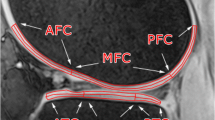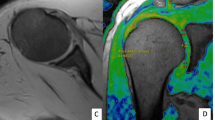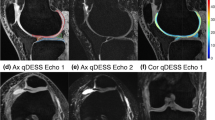Abstract
Objective
To evaluate the T2 mapping of patellar articular cartilage in patients with osteoarthritis using gradient and spin-echo (GRASE) magnetic resonance (MR) imaging.
Materials and methods
After the imaging of a phantom consisting of two sealed 50-ml test objects with different concentrations (30% and 90% weight/volume) of copper sulphate, the T2 mapping of patellar articular cartilage was performed in 35 patients (21 male and 14 female; mean age ± SD 42 ± 17 years) with moderate degree of patellar osteoarthritis. Turbo-spin-echo (TSE) (TR milliseconds/minimum–maximum TE milliseconds 3,000/15–120; total acquisition time 5 min 52 s) and GRASE (TR milliseconds/minimum–maximum TE milliseconds 3,000/15–120; total acquisition time 1 min 51 s) were employed. In each patient patellar cartilage was segmented at nine locations (three superior, three central, and three inferior) by manually defined regions of interest. T2 relaxation times were calculated using a linear fit applied to the logarithm of signal intensity decay.
Results
In the phantom the T2 values measured by GRASE were similar to those measured by MR spectroscopy (test object 1: 48.1 ms vs 51 ms; test object 2: 66.8 ms vs 71 ms; P > 0.05, Wilcoxon test). In patients GRASE and TSE-derived T2 values demonstrated good agreement (mean difference ± SD, 1.81 ± 3.63 ms). The within-patient coefficient of variation was 22% for TSE and 23% for GRASE.
Conclusion
Fast T2 mapping of the patellar articular cartilage can be performed with GRASE within a third of the time of that of standard sequences.





Similar content being viewed by others
References
Phan CM, Link TM, Blumenkrantz G, et al. MR imaging findings in the follow-up of patients with different stages of knee osteoarthritis and the correlation with clinical symptoms. Eur Radiol 2006; 16: 608–618.
Wheaton AJ, Dodge GR, Borthakur A, et al. Detection of changes in articular cartilage proteoglycan by T1(rho) magnetic resonance imaging. J Orthop Res 2005; 23: 102–108.
Toffanin R, Mlynárik V, Russo S, Szomolányi P, Piras A, Vittur F. Proteoglycan depletion and MR parameters of articular cartilage. Arch Biochem Biophys 2001; 390: 235–242.
Menezes NM, Grey ML, Hartke JR, Burstein D. T2 and T1(rho) MRI in articular cartilage systems. Magn Reson Med 2004; 51: 503–509.
Regatte RR, Akella SV, Lonner JH, Kneeland JB, Reddy R. T1(rho) relaxation mapping in human osteoarthritis (OA) cartilage: comparison of T1(rho) with T2. J Magn Reson Imaging 2006; 23: 547–553.
Laurent D, Wasvary J, Yin J, et al. Quantitative and qualitative assessment of articular cartilage in the goat knee with magnetization transfer imaging. Magn Reson Imaging 2001; 19: 1279–1286.
Williams A, Gillis A, McKenzie C, Po B, Sharma L, Micheli L, McKeon B, Burnstein D. Glycosaminoglycan distribution in cartilage as determined by delayed gadolinium-enhanced MRI of cartilage (dGEMRIC): potential clinical applications. AJR Am J Roentgenol 2004; 182: 167–172.
Koff MF, Amrami KK, Kaufman KR. Clinical evaluation of T2 values of patellar cartilage in patients with osteoarthritis. Osteoarthritis Cartilage 2007; 15: 198–204.
Xia Y. Heterogeneity of cartilage laminae in MR imaging. J Magn Reson Imaging 2000; 11: 686–693.
Mlynárik V, Degrassi A, Toffanin R, et al. Investigation of laminar appearance of articular cartilage by means of magnetic resonance microscopy. Magn Reson Imaging 1996; 14: 435–442.
Dardzinski BJ, Mosher TJ, Li S, et al. Spatial variation of T2 in human articular cartilage. Radiology 1997; 205: 546–550.
Mosher TJ, Dardzinski BJ, Smith MB. Human articular cartilage: influence of aging and early symptomatic degeneration on the spatial variation of T2—preliminary findings at 3 T. Radiology 2000; 214: 259–266.
Mosher TJ, Dardzinski BJ. Cartilage MRI T2 relaxation time mapping: overview and applications. Semin Musculoskelet Radiol 2004; 8: 355–368.
David-Vaudey E, Ghosh S, Ries M, Majumdar S. T2 relaxation time measurements in osteoarthritis. Magn Reson Imaging 2004; 22: 673–682.
Dunn TC, Lu Y, Jin H, Ries MD, Majumdar S. T2 relaxation time of cartilage at MR imaging: comparison with severity of knee osteoarthritis. Radiology 2004; 232: 592–598.
Maier CF, Tan SG, Hariharan H, Potter HG. T2 quantitation of articular cartilage at 1.5 T. J Magn Reson Imaging 2003; 17: 358–364.
Mendlik T, Faber SC, Weber J, et al. T2 quantitation of human articular cartilage in a clinical setting at 1.5 T: implementation and testing of four multiecho pulse sequence designs for validity. Invest Radiol 2004; 39: 288–299.
Feinberg DA, Oshio K. GRASE (gradient- and spin-echo) MR imaging: a new fast clinical imaging technique. Radiology 1991; 181: 597–602.
Oshio K, Feinberg DA. GRASE (gradient- and spin-echo) imaging: a novel fast MRI technique. Magn Reson Med 1991; 20: 344–349.
Kellgren J, Lawrence J. Radiological assessment of osteoarthritis. Ann Rheum Dis 1957; 16: 494–502.
Noyes FR, Stabler CL. A system for grading articular cartilage lesions at arthroscopy. Am J Sports Med 1989; 17: 505–513.
Bland M. Clinical measurements. In: Bland M, editor. Introduction to medical statistics. 3rd ed. Oxford: Oxford University Press; 2003. p. 268–275.
Van Breuseghem I, Bosmans HT, Elst LV, et al. T2 mapping of human femorotibial cartilage with turbo mixed MR imaging at 1.5 T: feasibility. Radiology 2004; 233: 609–614.
Glaser C. New techniques for cartilage imaging: T2 relaxation time and diffusion-weighted MR imaging. Radiol Clin North Am 2005; 43: 641–653.
Mosher TJ, Smith H, Dardzinski BJ, et al. MR imaging and T2 mapping of femoral cartilage: in vivo determination of the magic angle effect. AJR Am J Roentgenol 2001; 177: 665–669.
Xia Y, Farquhar T, Burton-Wurster N, Ray E, Jelinski LW. Diffusion and relaxation mapping of cartilage-bone plugs and excised disks using microscopic magnetic resonance imaging. Magn Reson Med 1994; 31: 273–282.
Goodwin DW, Dunn JF. MR imaging and T2 mapping of femoral cartilage. AJR Am J Roentgenol 2002; 178: 1568–1569.
Author information
Authors and Affiliations
Corresponding author
Additional information
This study was performed thanks to the support of a private grant, “Arduino Ratti”, provided through the Italian Society of Medical Radiology.
Rights and permissions
About this article
Cite this article
Quaia, E., Toffanin, R., Guglielmi, G. et al. Fast T2 mapping of the patellar articular cartilage with gradient and spin-echo magnetic resonance imaging at 1.5 T: validation and initial clinical experience in patients with osteoarthritis. Skeletal Radiol 37, 511–517 (2008). https://doi.org/10.1007/s00256-008-0478-8
Received:
Revised:
Accepted:
Published:
Issue Date:
DOI: https://doi.org/10.1007/s00256-008-0478-8




